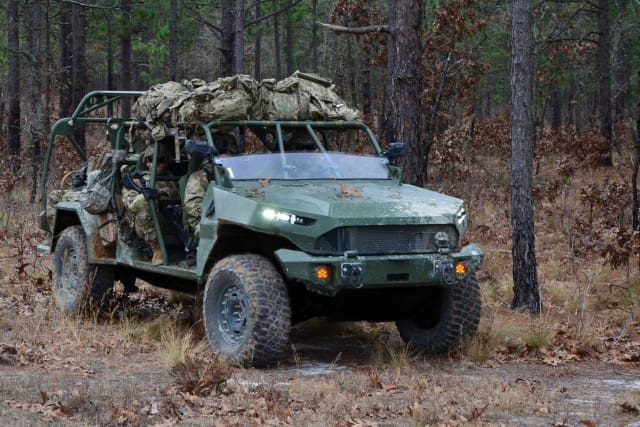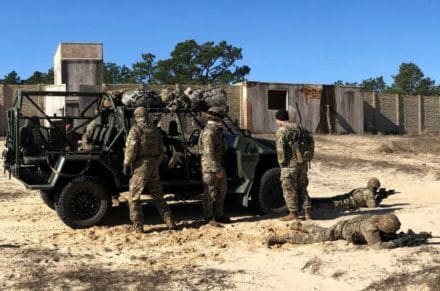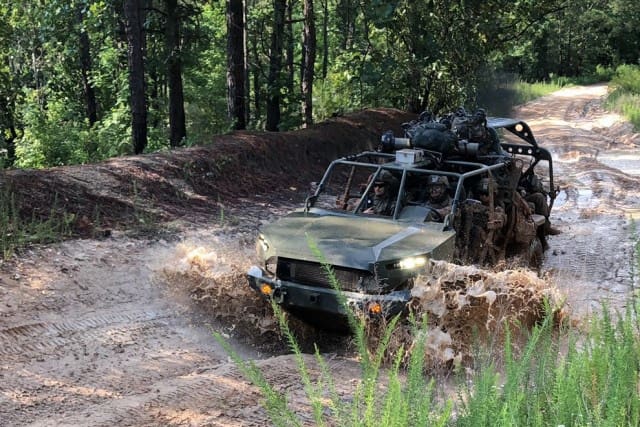In what many would consider an upset, GM Defense was selected to provide over 1,000 Infantry Squad Vehicles to the US Army. They beat out SAIC/Polaris and Osh-Kosh/Flyer both considered incumbents.
The Polaris DAGOR is in service with the 82nd Abn Div and the Flyer developed GMV 1.1 is in use with USSOCOM and the 173rd Abn Bde.
GM Defense LLC, Detroit, Michigan, was awarded a $214,297,869 firm-fixed-price contract for acquisition of the Infantry Squad Vehicle, installation kits, ancillary hardware and logistical support. Bids were solicited via the internet with three received. Work locations and funding will be determined with each order, with an estimated completion date of June 24, 2028. U.S. Army Contracting Command, Detroit Arsenal, Michigan, is the contracting activity (W56HZV-20-D-0066).
The GM ISV Is powered by a 186-horsepower, 2.8L diesel powerplant and six-speed automatic transmission, the nine man crew is protected by a Roll Over Protection System which serves as a roll bar, but can be stored for air transport.
Based on their successful Chevrolet Colorado midsize truck architecture and its ZR2 and ZR2 Bison variants, this GM truck could make the beginnings of an entire fleet of commercial off-road vehicles to handle the US military’s dat-to-day tasks in a similar fashion to the Commercial Utility Cargo Vehicle programs of the 70s-00s.
Below, is the US Army announcement.
Infantry Squad Vehicle to ‘motorize’ IBCTs

DETROIT ARSENAL, Mich. – The Army today announced it has selected GM Defense, LLC, Detroit, Mich., to produce the Infantry Squad Vehicle, or ISV, to motorize Infantry Brigade Combat Teams. Delivery of this modernized capability is slated to begin with the 1st Brigade, 82nd Airborne Division, as the designated First Unit Equipped next winter. The contract is valued at $214,297,869 and the Army intends to purchase 649 vehicles.
It is based on the Chevrolet Colorado ZR2 architecture, which will derive 90 percent of its parts from commercial-off-the-shelf components.
The ISV program provides IBCTs an additive lightweight vehicle to move Soldiers and their equipment quickly over complex and difficult cross-country terrain. ISVs will provide greater mobility to IBCTs, as they are designed to move across restrictive terrain, allowing Soldiers to close on objectives with less fatigue and greater readiness. The Army can deliver the vehicle to the field by airdrop or helicopter, which increases the flexibility of Soldiers on the move.

This is the second important production contract award for Army light tactical wheeled vehicle modernization programs of record in the last year. The Army announced in June 2019 the production contract of the Joint Light Tactical Vehicle. JLTV is modernizing the Army’s and U.S. Marine Corps’ light tactical wheeled vehicle fleets with a leap-ahead balance of payload, performance and protection.
“The Infantry Squad Vehicle meets the challenges we’ve faced to give our IBCT Soldiers greater mobility and increased survivability,” said Chris Stone, the Maneuver Capabilities Development and Integration Directorate’s deputy Army capability manager – Infantry Brigade Combat Team at Fort Benning, Ga. The CDID is the Army’s proponent for generating and validating the operational need for the Infantry Squad Vehicle.
“As the Army’s newest light tactical vehicle, ISV will allow IBCTs more flexibility and a greater advantage getting to the objective,” he added.
The ISV’s basic operational capabilities include:
Nine-man squad carrying capability
Payload of 3,200 lbs.
External sling load by a UH-60 Black Hawk helicopter
Internal load/external lift by CH-47 Chinook helicopter
Low-velocity air drop by fixed-wing C-130 or C-17 transport aircraft
Exceptional mobility over all terrains

The comprehensive team responsible for bringing the ISV program to production contract award involves not only Army acquisition professionals, but also relevant stakeholders representing the Army’s funding and testing communities, Army Futures Command, and Forces Command. Soldier evaluation via user-acceptance efforts has been a key element of the ISV program from the outset, and has helped compress the time it takes to field a modernized capability that meets infantry Soldiers’ needs.
“The Infantry Squad Vehicle program has focused on meeting the Army’s emphasis on enhancing Infantry Soldier mobility and survivability by rapidly fielding modernized capabilities. Our product management team for Ground Mobility Vehicles undertook a great challenge to develop a strategy using experimentation and technical demonstrations to streamline the ISV acquisition process,” said Timothy G. Goddette, the Army’s program executive officer for Combat Support and Combat Service Support, or PEO CS&CSS, headquartered here.
“Using an innovative acquisition approach through an Other Transaction Authority — a flexible, collaborative tool designed to speed acquisition and modernization — the ISV team awarded the production contract for this capability in 16 months. Using normal acquisition processes, it could have taken as many as 36 months,” Goddette explained.
The ISV acquisition strategy was structured to promote the highest level of competition possible, including affordability. Due to competition, the program office will realize a reduction from the original independent government cost estimate for the program. This provides best value to American taxpayers. What’s more, a senior Army officer who has commanded at all levels in an IBCT was tapped to serve as the ISV program’s Source Selection Authority.
According to Steve Herrick, the Army’s product lead for Ground Mobility Vehicles, PEO CS&CSS, the next steps in the ISV program include GM Defense delivering eight ISVs to Aberdeen Test Center in Maryland within four months. “Following delivery, our program office, along with Army testers, will execute an aggressive and tailored testing plan,” he said.
Herrick went on to explain the Army will conduct tailored production qualification testing to address the vehicles’ ability to meet the performance specifications in areas not previously tested. This will also build confidence in areas already tested, he said. The ISV will also undergo transportability certification, which includes low-velocity air drop and helicopter sling loading. Next summer and fall, the Army will hold an initial operational test and evaluation.
“The program office is marching toward delivering ISVs to the first unit, the 1/82nd at Fort Bragg, approximately eight months after the contract award,” Herrick added. “We are excited about the commercial nature this product brings to the Soldier, and in the future, we could possibly see greater leaps in technology and concepts to include reconnaissance or electric vehicles.”
By Rae Higgins, Program Executive Office for Combat Support & Combat Service Support


CUCV got fancy.
So this is a GM pickup without doors basically?
So basically a big Jeep / small Deuce-and-a-half. We sure have come a long way since WWII…
Meanwhile, the Russian airborne forces have had air-droppable, air-maneuverable armored infantry fighting vehicles since forever.
Wonder how survivable those Russian vehicles were on the drop.
Wow, GM seemed to come out of nowhere to take the prize.
Anyone have insight on the selection rationale?
Been following this initiative from afar for what feels like a decade. Glad to finally see it come to fruition.
GM’s board or directors is now mostly women from deep state and defense companies. GM appears to be going after defense in the future as well as data mining. Some will argue their “ONSTAR” system provided the insight into just how valuable data harvesting will be. GM’s board has a Lockheed executive as well as an exec from Kissinger & Associates. These people would have zero knowledge or interest in making “passenger cars” but will very valuable in the direction they want to go into.
Can anyone attest to how it compares to gmv 1.1/ flyer 72?
This will not bode well when it’s exposed to an IED. I acknowledge these have been seeing use and deployed, but have we yet to see one get hammered from the bottom?
This is just a scalable option, not a replacement for JLTVs or MRAPs. It’s meant to be a light and mobile fast attack vehicle or scouting option where something like a giant armored vehicle isn’t practical, not cruise down Route Irish. A MRZRs won’t survive daisy chained 155s either but they’re still handy as all hell in a combat theatre.
My question is what niche is this filling? Slightly lighter and faster than a Humvee? Off road so no armor?
The JLTV will be replacing most Humvee variants, this will be a lighter option for fast moving or air mobile infantry. This can fit inside a ch-47 so it can be deployed much easier than a JLTV, while providing more capability as a squad vehicle than a Humvee.
The ISV program is more geared towards major force on force conflicts, and its better for an infantry squad to go fast and not draw as much attention from anti tank weaponry than to try to counter it with armor. If anything that’s where the JLTV comes in.
This isn’t about comparing HMMWVs to the JLTV, they are completely in different categories.
Comparing a HMMWV to the ISV though is a fair comparison though. Looking at the RFP for the ISV, a light skinned HMMWV is not far off the mark.
Granted a 998 is underpowered and out of date, but curb weight is 5200 pounds, Max ISV weight is 5000.
Why field as completley new vehicle system that will require a new supply chain and a completely new skill set. You have mechanics that have spent their entire careers working on HMMWVs and a supply chain that’s already well established. Even with the current system it can be hard to get needed parts. What about when it’s a completely new vehicle system and it starts breaking parts?
^ This is a real question I have. A light skinned HMMWV is close to the weight requirements of the ISV. What other aspects are not met? To me it seems the added benefits of the HMMWV platform being well known by mechanics and all of the logistics and supply already set up for the HMMWV would far outweigh adding a new vehicle with slightly better performance.
Operational mobility. Joe doesn’t have to foot march with sustainment load on his back to have it readily available at an AA or ORP.
My concern is security of the vehicles when Joe leaves it to do Joe stuff. Having to wait for the bus from the CSSB Truck Co. limits operations, but it’s the Truck Co’s truck so you get to fight with everybody. Are ISV-equipped squads intended to habitually fight one man down to leave him “with the horses” like 19th century dragoons? Is the trade-off of improved mobility vs. fewer guys on the objective worth it?
You’ll have to secure the vehicles, so maybe the 4 vehicles stay at the ORP with the drivers and the platoon moves back to them after consolidation. This also answers the issue of airfield seizure in the modern battlefield. Instead of trying to force a BN into denied airspace, they can drop offset by 50km and then move mounted to conduct the airfield seizure in small vehicles that can move down trails and normal roads at much higher speeds than the HMMWV, LMTV, or legacy vehicles were capable of. The tactical considerations of securing the equipment are small in comparison to the gains available with this capability.
The HMMWV can go away. Its too wide to be used to very restricted trails and tighter terrain, outside of the high back you can’t put a squad in it. This is a good step forward to increase the operational mobility of the IBCT, and we should let junior leaders train with them and let us develop new doctrine for it.
Taliban and others be fielding their Toyota Technical Truck we be ridin into battle with our Chevy Colorados …Let the battle begin !!
Unlike the go anywhere Toyota, the chevy doesn’t appear to have mounts for light/medium machine guns. Looks like an unprotected people and all of their crap mover to me but, i’m old and retired. Good luck,
How long will it be before some grunt welds a machine gun mount to one of these? It is inevitable that these are going to be armed.
Did i read this correctly? 214 million for 650 vehicles? Just how special are the 10% non COTS parts?
Y’know, Mahindra makes an almost exact copy of the Willys jeep for around $20,000.
Numbers doubled.
I’m so old I know why calling it The New CUCV isn’t a selling point, lol.
Crazy, those Flyer variants have been at the GD booth as you enter SOFIC for the last 8 yrs.
I really thought they had it in the bag! Damn!
Lotta naysayers here these days.
Will it stand up to land mine or IED? Prolly not. Remember tho, as soon as we started deploying “mine resistant” vehicles, the bad guys just made bigger bombs. This vehicle will allow our troops to access an AO using alternate ingress routes. Bad guys can’t mine and overwatch all routes leading into an AO.
I think this is an incredible idea. The SAS did this in North Africa during WWII against the Germans. Worked pretty well too. Wasn’t it the Chadians that defeated the Libyan armor division using Toyota “technicals”? The Russians are developing/deploying the same concept currently too.
There is definitely a place for a high speed, very maneuverable, light skinned vehicle on the modern battle field.
Same guys who think you wear FR clothing and full armor in the jungle. It’s all they’ve ever known.